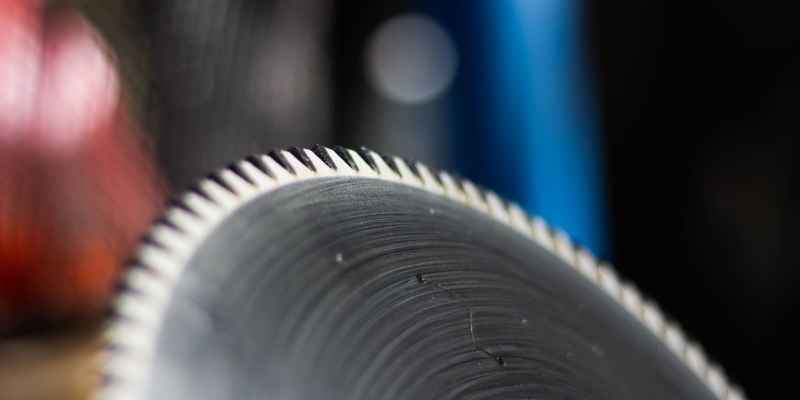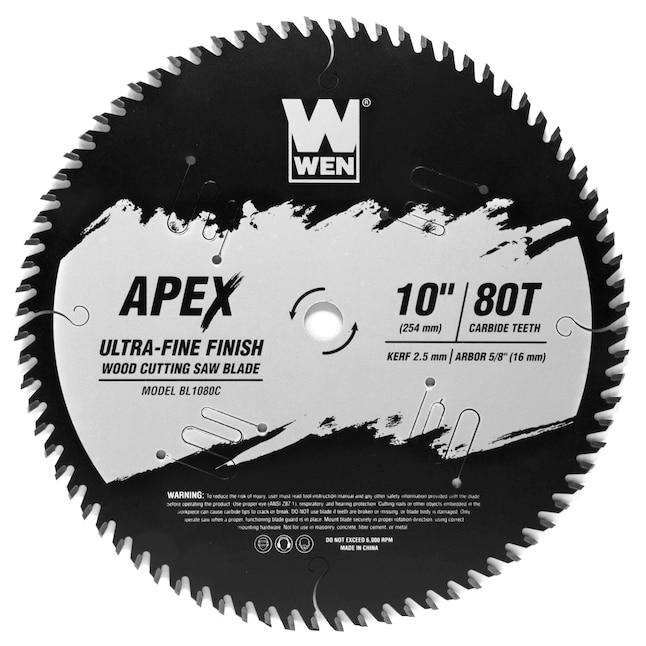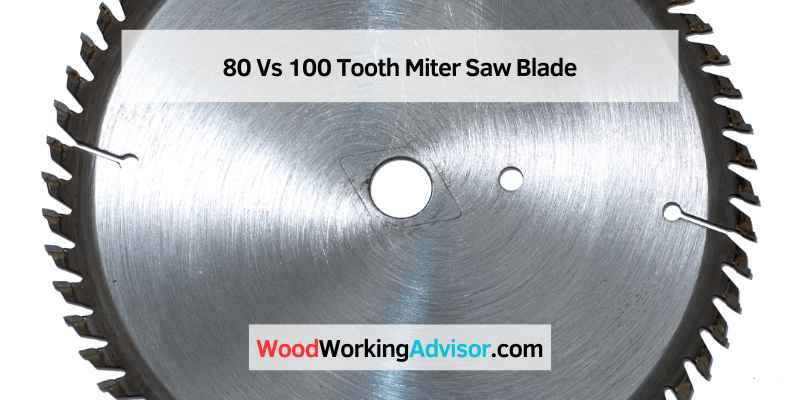An 80-tooth miter saw blade makes clean, precise cuts in wood. It can handle most types of wood, including hardwoods and softwoods. If you’re looking for a versatile miter or saw blade that can tackle various projects, an 80-tooth edge is a good choice.
A 100-tooth miter saw blade is designed for cutting softer materials, such as aluminum or vinyl. It’s also a good choice for making detailed cuts in wood. If you need to make precise cuts or want a cleaner cut edge on your workpiece, a 100-tooth blade is the better option.

24 teeth vs. 60 teeth Saw Blades
There’s a considerable debate in the world of woodworking about which size miter saw blade is better – 80 or 100 teeth. Each has advantages and disadvantages, so it depends on what you’re looking for in a knife.
Here’s a quick rundown of each option:
80 Tooth Blades:
– Good for general-purpose use
– Can handle cross-cuts and light rip cuts
– More affordable than 100 tooth blades
100 Tooth Blades:
– Excellent for fine, precise cuts
60 Vs. 80 Tooth Miter Saw Blade
Miter saws are an essential tool for anyone who does a lot of woodworking or carpentry. They allow you to make precise cuts at various angles, which is necessary for a clean, professional look. There are two main miter saw blades: 60-tooth and 80-tooth.
Each has its benefits and drawbacks, so it’s essential to choose the right one for your needs. Sixty tooth blades are great for making quick, rough cuts. They’re also suitable for cutting through softer woods without leaving behind too much debris.
However, they can leave behind a rougher finish and aren’t as effective on harder woods. Eighty-tooth blades provide a much smoother cut and are ideal for cutting hardwoods. They’re also great for trim work and other applications where a clean, finished look is desired.
However, they take longer to make each cut and can be more expensive than 60 tooth blades. So, which type of blade should you choose? It depends on what you’ll be using it for most often.
If you do a lot of different types of woodworking projects, it might be worth investing in both blades so you have them when you need them.
Diablo 80 Tooth Vs. 100 Tooth
There’s a lot to consider when choosing between a Diablo 80-tooth blade and a 100-tooth blade. The number of teeth on edge will affect the cut’s quality and speed. A lower number of teeth means that each tooth is more significant, making it ideal for more rigid materials like wood.
A higher number of teeth results in smaller individual teeth better suited for softer materials like aluminum or plastic. The other factor to consider is the angle of the cut. A steeper angle (like that found on an 80-tooth blade) will be more aggressive, meaning it can easily handle tougher cuts.
However, it also produces more dust and debris than a shallower angle (like that found on a 100-tooth blade). Ultimately, the decision between a Diablo 80-tooth blade and a 100-tooth blade comes down to personal preference and the specific project you’re working on. If cutting something soft or delicate, go with the 100-tooth knife.
If you’re tackling something tough or thick, opt for the 80-tooth blade.
80 Vs. 90 Tooth Saw Blade
When it comes to saw blades, there are many different options available on the market. Two common blade types are 80-tooth and 90-tooth blades. So, what’s the difference between these two types of knives?
And which one should you use for your next project? 80-Tooth Blades An 80-tooth blade is an excellent all-purpose blade that can be used for various tasks.
It’s an excellent choice for those who don’t do much woodworking or are just starting. The downside to an 80-tooth blade is that it doesn’t cut as quickly as a 90-tooth blade. It also produces more tear-out on the back side of the cut material.
90-Tooth Blades A 90-tooth blade is better for those with more precision woodworking. It cuts more quickly and smoothly than an 80-tooth blade and produces more tear-out.
If you’re looking for the best possible finish, then a 90-tooth blade is the way to go. However, if speed is your priority, an 80-tooth knife will do just fine.
40 Or 60 Tooth Saw Blade
There are two types of saw blades that you can choose from when looking for the right one – a 40-tooth or 60-tooth knife. The number of teeth on edge will determine how fast it cuts and how smooth it is. If you’re looking for a quick, rough cut, then a 40-tooth blade is ideal.
If you want a slower, smoother cut, go for a 60-tooth blade.
What is a 32 Tooth Saw Blade Used for
A 32-tooth saw blade is a versatile tool that can be used for various tasks. Here are a few examples: -Cutting through softwoods like pine or cedar.
-Making precise cuts in hardwoods like oak or maple -Trimming laminate flooring
Miter Saw Blade Teeth Guide
A miter saw is a powerful tool that helps make quick, precise cuts in wood. The blade on a miter saw can have different numbers of teeth, which will affect the quality of the amount. Here is a guide to help you choose the right blade for your project:
The number of teeth on a miter saw blade will determine how smooth or coarse the cut will be. You will want to use a knife with more teeth if you need a very soft amount. For example, an 80-tooth edge will give you a much smoother finish than a 24-tooth blade.
You can choose a lower tooth count if you are looking for a rougher cut. Remember that the more turbulent the amount, the more likely your project will not turn out as planned. Another thing to consider when choosing a miter saw blade is the type of material you will be cutting.
Some blades are designed to cut softwoods, while others can handle softwoods and hardwoods. If you are unsure about what kind of Blade you need, ask someone at your local hardware store for help.
40-Tooth Saw Blade
If you’re looking for a powerful and versatile saw blade, the 40-tooth saw knife is a great option. This blade can handle a variety of materials, including wood, metal, and plastic. It’s also able to make precise cuts thanks to its sharp teeth.
Best Miter Saw Blade
A miter saw is a tool used to make precise cuts in wood. The blade on a miter saw is mounted on an adjustable arm that allows the user to make angled cuts. A miter saw is an essential tool for any woodworker, and having the best miter saw blade will help you make the most precise cuts possible.
Many types of miter saw blades are available on the market, and choosing the right one can be confusing. This blog post will discuss the different kinds of knives available and which is best for your needs. We will also provide tips on caring for your cutters to ensure they last as long as possible.
The first type of blade we will discuss is the standard blade. Standard blades are made from high-carbon steel and designed for general cutting. These blades are affordable and can be used on various materials, but they are not ideal for precision cuts.
If you need to make a lot of cuts or are working with hardwoods, then a standard blade may be right for you. The second type of blade is the carbide-tipped blade. Carbide-tipped blades are made from a more rigid material than standard blades and stay sharper for extended periods.
These blades are more expensive than standard blades, but they will save you money in the long run because you won’t need to replace them as often. If you only occasionally need to use a miter saw or plan on using it primarily for softwoods, then a carbide-tipped blade may be a good option. The third type of blade is the diamond-tipped blade.
Diamond-tipped blades are made from industrial diamonds that have been embedded into the metal of the blade. These Blades offer superior performance and durability but come at a higher price than standard and carbide-tipped Blades. If money is no object and you demand only the best performance from your tools, diamond-tipped Blades are worth considering.

Credit: www.lowes.com
What is an 80 Tooth Saw Blade Used For?
An 80-tooth saw blade is primarily used to cut through softer woods and create clean cuts quickly. The more teeth a saw blade has, the smoother the amount will be. However, more teeth also mean that the edge will wear out faster.
What is a 100 Tooth Saw Blade Used For?
A 100-tooth saw blade is a type of circular saw blade typically used to make exact cuts in wood. This type of blade has a very high number of teeth per inch, allowing it to cut through wood smoothly and quickly. One hundred-tooth blade are also often used for cutting laminate flooring and other types of hardwood.
Is It Better to Have More Teeth on a Mitre Saw Blade?
When it comes to miter saw blades, the number of teeth on the edge is a significant factor. More teeth generally mean a smoother cut, but Comtrade-offs also need to be considered.
Here’s a look at some of the pros and cons of having more teeth on a miter saw blade:
Pros:
• More teeth usually mean a cleaner and smoother cut. This is because there are more cutting points per inch, which results in less tear-out and chipping.
• Blades with more teeth can handle tougher cuts, such as hardwoods and composite materials. They can also make cleaner cuts in softer materials like plywood and MDF.
Cons:
• More teeth also mean more friction, leading to heat build-up and premature wear on the blade.
How Many Teeth is Best for Mitre Saw Blade?
A miter saw is used to make precise cuts at various angles. The blade on a miter saw is mounted on an adjustable arm that allows the user to change the tip of the amount. The chop saw is the most common type of miter saw, which has a fixed blade that can be set at different angles.
The size of the blade on a miter saw will determine how many teeth it has. A 10-inch knife typically has 40 teeth, while a 12-inch knife will have 60 teeth. The number of teeth on edge will impact how smooth the cut is and how long it takes to cut.
A higher tooth count will result in a smoother cut, but it will also take longer.
Conclusion
Are you looking for a miter saw blade that will give you the best cuts possible? If so, you may wonder if you should get an 80-tooth blade or a 100-tooth blade. Both knives have their benefits and drawbacks, so it’s important to know what each offers before deciding.
An 80-tooth blade is excellent for cutting through softwoods and plywood. It can also handle crosscuts and rip cuts with ease. The main downside of an 80-tooth edge is that it produces more tear-out than a 100-tooth blade.
A 100-tooth blade is ideal for cutting through more rigid materials like metal or concrete. It also leaves a much smoother finish than an 80-tooth blade. However, a 100-tooth knife can be more expensive and unnecessary for everyone’s needs.



6 thoughts on “80 Vs 100 Tooth Miter Saw Blade”